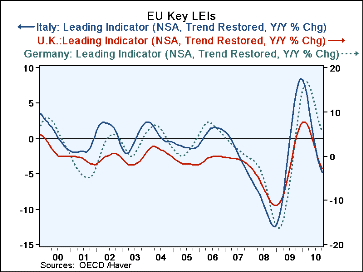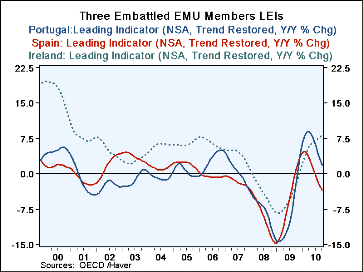 Global| Dec 13 2010
Global| Dec 13 2010EMU And More Trends Are Cooling Off
Summary
The OECD LEI is off in October. For the US index there is still some uptick in October compared to September. But Japan's index is off by 0.4% despite increasingly consistent gains in the Nikkei stock index in Japan. Germany's index [...]
 The OECD LEI is off in October. For the US index there is still some uptick in October compared to September. But Japan's index
is off by 0.4% despite increasingly consistent gains in the Nikkei stock index in Japan. Germany's index turns lowers despite a
brightened outlook by the Bundesbank.
The OECD LEI is off in October. For the US index there is still some uptick in October compared to September. But Japan's index
is off by 0.4% despite increasingly consistent gains in the Nikkei stock index in Japan. Germany's index turns lowers despite a
brightened outlook by the Bundesbank.
Over the last three months only the US index is still expanding while the other main OECD indices, all of which include the US except the index dedicated to Japan, are lower. The US is still one of the few positive stories in town.
The chart shows in terms of Yr/Yr changes that Italy and the UK are already in the red. Despite some bright current German data, the OECD trend-adjusted indicators that look ahead do not paint a very bright picture for Germany.
Turning our attention to three embattled EMU members, Spain Portugal and Ireland we see only Ireland showing acceleration. Yet, with the new Ireland debt-deal nearly in hand, that signal is certain to be snuffed out. Spain with austerity programs in gear is slowing sharply. Portugal, under pressure from markets, trying to squirm out of it, and with some austerity plans going into effect, is also losing forward momentum fast.
Over the most recent periods the US economy is putting out the best signals among these various OECD groups tracked in the table. But the US is slowing too. The indices in Germany point to slowing but the Bundesbank has recently issued a more buoyant forecast. Economists are getting more upbeat on the US economy as well after a period of uncertainty. In Japan a dismal showing by the OECD LEI flies in the face of ongoing gains in Japan's stock market. This leads us to wonder if the OECD's signals are correct. In the case of Ireland the OECD index is missing all the recent action in markets. For Spain and Portugal their difficult straits are underlined by the OECD indices. The circumstances of the most industrialized economies are still being hotly debated.
| OECD Trend-Rrestored Leading Indicators | ||||||
|---|---|---|---|---|---|---|
| Growth:M/M | Growth Progression-SAAR | |||||
| Oct-10 | Sep-10 | 3Mo | 6Mo | 12Mo | Yr-Ago | |
| OECD | -0.1% | -0.1% | -1.5% | -1.7% | 1.7% | 3.3% |
| OECD7 | -0.1% | -0.1% | -1.8% | -2.3% | 1.5% | 2.3% |
| OECD.Japan | -0.4% | -0.3% | -3.5% | -2.6% | 1.8% | -2.7% |
| OECD US | 0.1% | 0.0% | 0.1% | -1.1% | 3.1% | 1.7% |
| Six Months | Six Month Readings at 6-Mo Intervals: | |||||
| Change in 6Mo avg | Recent six | 6Mo Ago | 12Mo Ago | 18Mo Ago | ||
| OECD | 0.1% | 0.7% | -1.7% | 5.2% | 14.0% | -6.3% |
| OECD7 | -0.1% | 0.5% | -2.3% | 5.3% | 14.6% | -8.6% |
| OECD.Japan | 0.1% | 0.9% | -2.6% | 6.5% | 10.8% | -14.6% |
| OECD US | 0.6% | 1.2% | -1.1% | 7.4% | 15.1% | -10.2% |
| Slowdowns indicated by BOLD RED | ||||||
Robert Brusca
AuthorMore in Author Profile »Robert A. Brusca is Chief Economist of Fact and Opinion Economics, a consulting firm he founded in Manhattan. He has been an economist on Wall Street for over 25 years. He has visited central banking and large institutional clients in over 30 countries in his career as an economist. Mr. Brusca was a Divisional Research Chief at the Federal Reserve Bank of NY (Chief of the International Financial markets Division), a Fed Watcher at Irving Trust and Chief Economist at Nikko Securities International. He is widely quoted and appears in various media. Mr. Brusca holds an MA and Ph.D. in economics from Michigan State University and a BA in Economics from the University of Michigan. His research pursues his strong interests in non aligned policy economics as well as international economics. FAO Economics’ research targets investors to assist them in making better investment decisions in stocks, bonds and in a variety of international assets. The company does not manage money and has no conflicts in giving economic advice.







